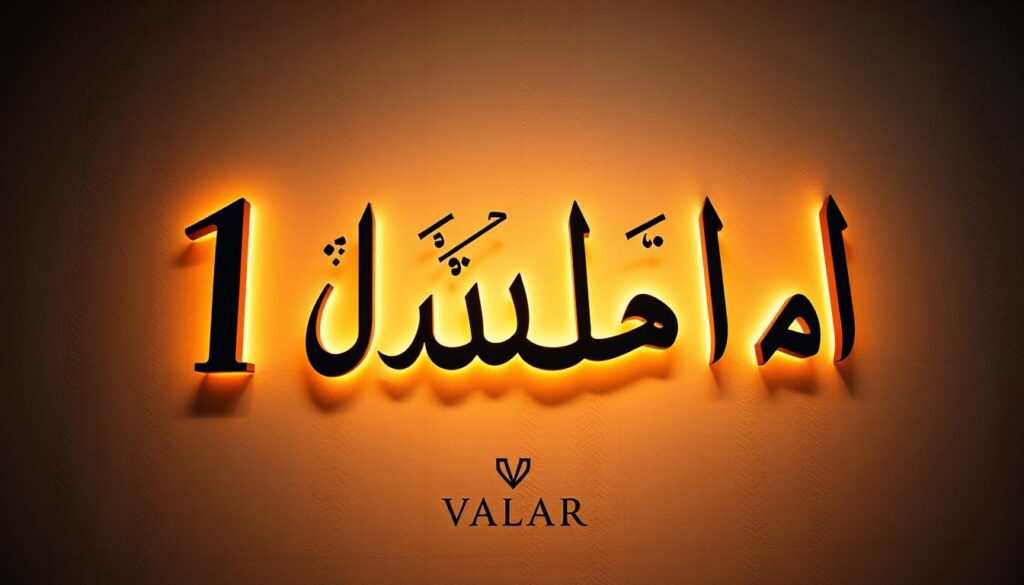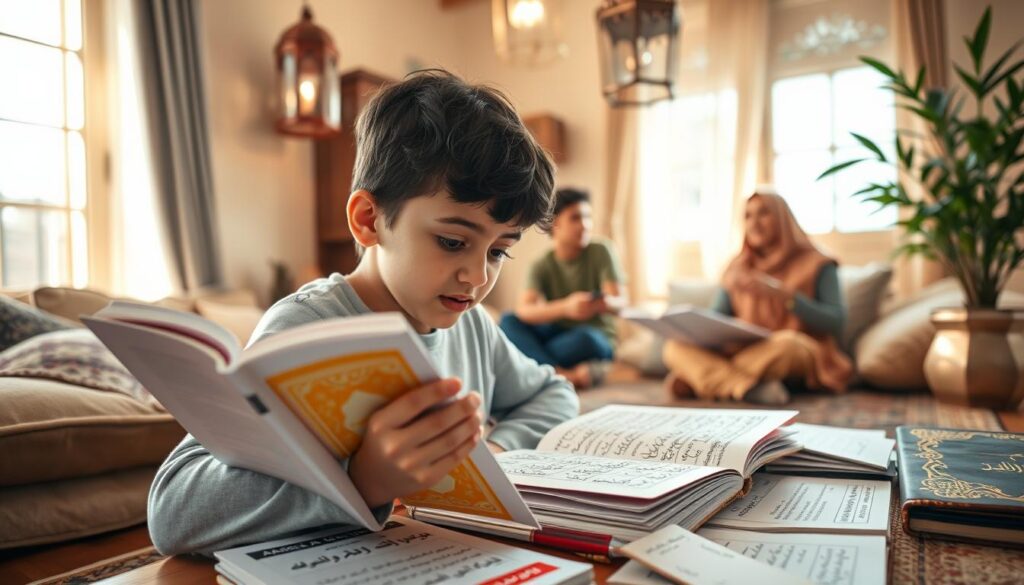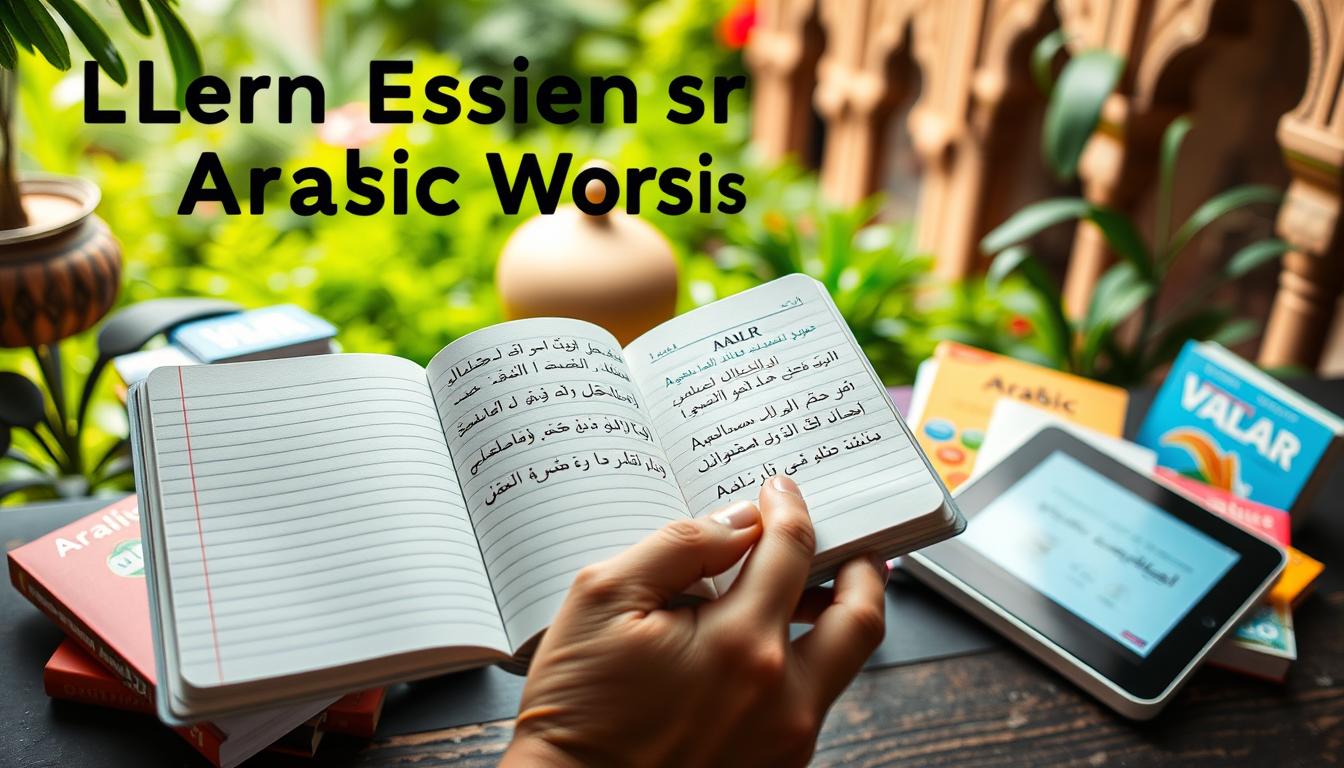The Arabic language has over 120,000 words, making it very rich. Learning Arabic can be very rewarding. With the right tools, anyone can start to learn Arabic.
Knowing Arabic vocabulary is key to daily communication. You only need to learn about 1,000 common words to start talking and connecting with locals.
Learning Arabic can be tough, but it’s also fun. Arabic has its own way of speaking and writing. Knowing these rules is important to learn Arabic well.
Table of Contents
The Importance of Learning Arabic Words
Learning Arabic can greatly improve your life. It’s a key skill for work and travel. With over 400 million speakers, Arabic is a major language worldwide.
Knowing basic arabic phrases makes daily life easier. It’s useful for travel, business, and learning about different cultures.
Recently, more people want to learn a second language, like Arabic. This is true even when they can’t travel. Learning Arabic can also make you earn more. Plus, it boosts your brain power, helping with memory and problem-solving.
Some good things about learning Arabic are:
- It can help you find better jobs and make your resume stand out.
- Learning with your family makes it more fun and rewarding.
- It also makes your brain sharper, improving memory and thinking skills.
Learning Arabic is a great choice for anyone. It opens doors to new experiences and opportunities. With practice and the right tools, you can become fluent and grow personally and professionally.
Essential Arabic Greetings
Learning basic greetings is key when starting with Arabic. Arabic greetings are a big part of the culture. They help you connect with native speakers. You can find online resources or use language learning apps to learn these greetings.
In Arabic culture, there are formal and informal greetings. Formal greetings like “As-salamu alaykum” (peace be upon you) are for formal situations. Informal greetings, such as “Ahlan” (hello), are for friends or casual settings. Knowing the difference is important when learning Arabic.
Here are some common Arabic greetings:
- As-salamu alaykum (peace be upon you)
- Marhaban (hello)
- Ahlan (hello)
- Sabah al-khayr (good morning)
- Masaa al-khayr (good evening)
Learning Arabic greetings helps you build strong relationships. It also makes your language learning journey better. By using these greetings every day, you’ll get better at Arabic and feel more confident.
Everyday Arabic Vocabulary
Learning everyday Arabic vocabulary is key for talking with people in Arabic-speaking countries. Start with over 100 common words to grow your vocabulary. Arabic flashcards and arabic word games can help you remember new words.
Words for food, drink, and home items are part of everyday vocabulary. For instance, “peace” (سَلام), “book” (كِتاب), and “water” (ماء) are vital for daily chats. Use these to make your own arabic flashcards and practice with arabic word games.
These words fit into many situations. Using them in arabic word games boosts your confidence in speaking Arabic.
Numbers in Arabic
Learning Arabic numbers is key to studying the Arabic language. To learn arabic words, you need to understand the Arabic number system. It has two main systems: Eastern and Western Arabic numerals.
The Western Arabic numerals were adopted by Europe in the 10th century. By the 15th century, they became the standard number system.
When using arabic language study materials, start by counting from one to ten. The numbers one to ten in Arabic are: 0 (٠), 1 (١), 2 (٢), 3 (٣), 4 (٤), 5 (٥), 6 (٦), 7 (٧), 8 (٨), 9 (٩), and 10 (١٠). Knowing these numbers is key to learning Arabic words and phrases.
These include prices, phone numbers, and dates.
Here is a table to help you learn Arabic numbers:
| Number | Arabic Numeral | English Translation |
|---|---|---|
| 1 | واحد | One |
| 2 | اثنين | Two |
| 3 | ثلاثة | Three |
| 4 | أربعة | Four |
| 5 | خمسة | Five |

For those interested in learn arabic words and phrases, the Arabic number system is a good starting point. With practice and the right arabic language study materials, you can master Arabic numbers. This will help improve your overall language skills.
Food-Related Arabic Words
Learning Arabic vocabulary about food is key for daily chats. Phrases like “صحتين” (enjoy your meal) and “فاتورة” (bill) are useful in dining out. They also give a peek into the local culture and traditions.
Common Arabic food terms include “خُبز” (bread), “لحم” (meat), and “خضار” (vegetables). These words help you order at Arabic restaurants or markets. Learning cooking terms like “طَبَخ” (to cook) and “مِقلاة” (pan) is also handy for talking to chefs or vendors.
- “مِلْعَقة” (spoon)
- “سِكين” (knife)
- “طَهِي” (cooking)
- “مِقلاة” (pan)
- “فرن” (oven)
By mastering these Arabic food words and phrases, you’ll improve your dining experiences. It’s also a great way to connect with Arabic-speaking communities. Whether you’re traveling or just exploring new foods, knowing these terms is a valuable skill.
Basic Travel Vocabulary
Traveling to Arabic-speaking countries requires learning basic travel vocabulary. Over 400 million people speak Arabic worldwide. Knowing key phrases can greatly improve your interactions with locals. Arabic language learning is very useful, thanks to the Middle East’s rich culture and resources.
Start by learning common greetings and phrases. Here are some essential Arabic phrases for travelers:
- As-salaam Alykum (Peace be Upon You)
- SabaaH Alkhayr (Good Morning)
- Hal TataHaddath Al’ingiliiziyya? (Do You Speak English?)
Knowing basic travel vocabulary, like directions and transportation, is also helpful. For example, asking for directions or transportation options can save time and reduce stress. Learning an arabic word list related to travel helps you navigate new places confidently.

Learning Arabic can also lead to cultural immersion and exchange. Arabic language skills are in high demand, increasing by 25% in the job market. Whether for business or pleasure, knowing basic Arabic travel vocabulary can greatly enhance your experience.
Family and Relationship Terms
Learning Arabic words for family and relationships is key to connect with the culture and talk effectively. To learn Arabic words, it’s important to grasp the language’s nuances. For example, “cousin” in Arabic has different terms like ابن عم (son of uncle) and ابنة عم (daughter of uncle).
The nuclear family includes parents (والدين), children (أولاد), brothers (إخوة), and sisters (أخوات). The most common name for a father in Arabic is أَبْ, with various dialectal variations. Using arabic flashcards can help learners remember these terms and their variations. The term for mother is أُمْ, with ماما being the most common affectionate term across dialects.
Here are some key family terms in Arabic:
- أَبْ (father)
- أُمْ (mother)
- ابن (son)
- بنت (daughter)
- جد (grandfather)
- جدة (grandmother)
Mastering these family terms can be done through online Arabic courses, like those from the Kalimah Center. These courses offer a detailed way to learn Arabic vocabulary, including how to learn arabic words and using arabic flashcards for effective memorization.
Thematic Vocabulary: Colors and Shapes
Learning Arabic vocabulary can be fun with arabic word games and study materials. These tools help learners understand and remember thematic vocabulary. This includes common colors and basic shapes in Arabic.
Colors are all around us, and learning their names in Arabic can be enjoyable. Some common colors in Arabic are aswad (black), abyad (white), and ahmar (red). Learners can practice pronunciation and spelling with arabic language study materials.
Basic shapes are also key in Arabic vocabulary. Shapes like duaira (circle), murabba (square), and mutahharrik (triangle) can be learned through games and activities. These shapes are useful for everyday talks and understanding math and geometry.
Using arabic word games and study materials can help learners grasp thematic vocabulary. This includes colors and shapes. It builds a strong foundation in Arabic and boosts language skills.
Learning Resources: Where to Start
Learning Arabic can be easier with the right tools. Over 300 million people speak Arabic worldwide. There are many apps, websites, and books to help you learn arabic words and grow your arabic vocabulary. It’s important to find what works best for you.
Apps like Duolingo and Memrise offer interactive lessons. They use spaced repetition to help you remember words. Websites like ArabicPod101 and BBC Languages also have free lessons to learn Arabic basics.
Books and courses are also great for learning Arabic. Al-Kitaab covers reading, writing, speaking, and listening. Madinah Arabic offers free courses for Quranic Arabic. You can pick the method that fits your style and goals.
Success in Arabic learning comes from practice and dedication. Use different resources and practice every day. You can start speaking in a few months and keep improving your arabic vocabulary. With the right approach, anyone can learn Arabic and explore new opportunities.
Tips for Practicing Arabic Words
Learning Arabic takes hard work and regular practice. To remember words better, try using flashcards and mnemonic devices. These methods help link the word, its sound, and its meaning in your brain.
Talking with native speakers is key to getting better at basic Arabic phrases. You can do this through language exchange programs, social media, or meeting people in person. This way, you’ll learn faster and get to know the culture better.
FAQ
What is the importance of learning Arabic words for beginners?
What resources are available to learn Arabic vocabulary?
What are some common Arabic greetings and phrases?
What are some useful everyday Arabic vocabulary words?
How can I learn to count in Arabic?
What Arabic vocabulary is useful for ordering food?
What Arabic words and phrases are important for travelers?
What Arabic vocabulary is useful for discussing family and relationships?
What are some common Arabic words for colors and shapes?
What are some recommended resources for learning Arabic?
How can I effectively practice and memorize Arabic words?
Source Links
- Basic Arabic words & phrases | Your intro to a fluent conversation in Arabic – https://preply.com/en/blog/basic-arabic-words/
- Arabic Words And Vocabulary For Beginners – KALIMAH – https://kalimah-center.com/arabic-words/
- 5 Reasons to Study Arabic – Arab Academy – https://www.arabacademy.com/5-reasons-to-study-arabic/
- 5 Powerful Reasons to Learn Arabic in 2025 | Alifbee Blog – https://blog.alifbee.com/learn-arabic-in-2025/
- Arabic Greetings and Responses | Powerful Greetings you Need – https://arabictutoronline.com/arabic-greetings-and-responses/
- Hello And Goodbye In Arabic: A Guide To Greetings And Farewells – https://www.babbel.com/en/magazine/hello-and-goodbye-in-arabic
- 15 Essential Arabic Words You Need to Learn – https://www.learnreadquran.com/essential-arabic-words/
- Top 100 Common Words in Arabic [with Tips] | Alifbee Blog – https://blog.alifbee.com/100-common-words-in-arabic/
- 101 Essential Common Arabic Phrases You Must Know – https://arabictutoronline.com/common-arabic-phrases/
- Most Used MSA Arabic Vocabulary And Classical Arabic Vocabulary – KALIMAH – https://kalimah-center.com/msa-arabic-vocabulary/
- Arabic Numbers 1 to 20 for Beginners – https://www.madinaharabic.com/blog/arabic-numbers-1-to-20.html
- Arabic Numbers: The Ultimate Guide – StoryLearning – https://storylearning.com/learn/arabic/arabic-tips/arabic-numbers
- Learn Numbers in Arabic 1- 100 [Complete Guide + Free Quiz] | Alifbee Blog – https://blog.alifbee.com/learn-numbers-in-arabic-1-100/
- 10 Arabic Expressions Inspired by Food and Eating | Alifbee Blog – https://blog.alifbee.com/arabic-expressions-inspired-by-food/
- Cooking and culinary phrases in Arabic – Talkpal – https://talkpal.ai/vocabulary/cooking-and-culinary-phrases-in-arabic/
- Arabic vocabulary for food and dining – Talkpal – https://talkpal.ai/vocabulary/arabic-vocabulary-for-food-and-dining/
- Learn Arabic for Travel – Converse With Confidence! – https://arabictutoronline.com/learn-arabic-for-travel/
- 6 Arabic Words and Phrases To Learn for Travel – Arab Academy – https://www.arabacademy.com/6-arabic-words-and-phrases-to-learn-for-travel/
- 50 Arabic Words to Navigate Airports and Flights – https://softarabic.com/50-arabic-words-to-navigate-airports-and-flights/
- Family Members in Arabic: Key Terms (MSA & dialects with audio!) – Playaling – https://playaling.com/family-members-in-arabic/
- Family Members In Arabic And Relatives In Arabic – 26 Terms – KALIMAH – https://kalimah-center.com/family-members-in-arabic/
- Learn Arabic Basics From Scratch: Full Guide To All The Aspects Of Arabic – KALIMAH – https://kalimah-center.com/learn-arabic-basics/
- Different Shapes: A Complete List of All Shapes and Their Names – https://promova.com/english-vocabulary/shapes-english-vocabulary
- Top 11 Free Arabic Cartoons, Shows, And Movies For Kids – KALIMAH – https://kalimah-center.com/arabic-cartoons-for-kids/
- Top 10 Resources for Learning Arabic Online: The Ultimate Guide – https://arabiclearning.in/blog/best-resources-for-learning-arabic.html
- 7 Steps To Learning Arabic – Arab Academy – https://www.arabacademy.com/7-steps-to-learning-arabic/
- The Top Hacks for Studying Arabic – https://blog.alifbee.com/top-hacks-for-studying-arabic/
- How to Memorize Arabic Vocabulary – Madinah Arabic – https://www.madinaharabic.com/blog/how-to-expand-your-arabic-vocabulary.html
- Teach yourself Arabic: 10 tips for learning Arabic on your own – https://preply.com/en/blog/how-to-teach-yourself-arabic/

